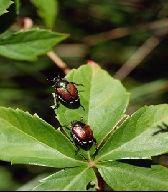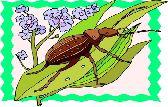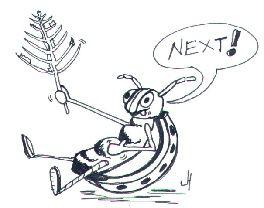Natural Solutions to Things That Bug You (48 page)
Read Natural Solutions to Things That Bug You Online
Authors: Myles Bader

TRAP THEM
There a number of commercial traps that work very well with Japanese beetles. Check with your local garden shop for trapping supplies. Use Geraniol oil, which is a rose scent to lure them into the trap.

FEED THEM FRUIT SALAD
Place a small can of fruit salad with the top removed in a safe location where neither animals nor insects can get to it and allow it to ferment. Use a large yellow bowl and place the can in the center raised up on a block of wood.
Fill the bowl with soapy water to below the top of the can and place the bowl in the garden about 20 feet from the plants that are infested with the beetle.
FEED SPORES TO GRUBS
One of the best remedies to control larvae of Japanese beetles is called “milky spores
(Bacillus popilliae).”
These spores can be purchased through a garden shop and are spread on the soil causing the grubs to contract a disease that kills them. The milky spores will not harm any beneficial organisms and only kills the grubs, thus eliminating the Japanese beetles. The milky spores will remain in the soil for many years just waiting for the grubs to appear. If you apply milky spore disease to your lawn and even fruit orchards it will eliminate the grub problem. The Japanese beetles can spend as much as 10 months every year as grubs in the soil.
LEAF BEETLES
General Information:

 There are many varieties of leaf beetles that attack the leaves on all trees. One of the best methods of eradication is to bring a beetle to your local nursery or garden store for identification and their recommended treatment. In most instances the best all-natural method will be to use a beneficial insect to control them such as BT.
There are many varieties of leaf beetles that attack the leaves on all trees. One of the best methods of eradication is to bring a beetle to your local nursery or garden store for identification and their recommended treatment. In most instances the best all-natural method will be to use a beneficial insect to control them such as BT.
MAY BEETLE
General Information:
There are over 100 species of May beetle and will cause damage by eating blackberry leaves. However, in the larval or white grub stage they will eat the roots of bluegrass, timothy corn, soybeans and other crops. They deposit their eggs one to eight inches deep into the soil during the spring and hatch about 3-4 weeks later. Keep an eye out for the white grubs in the spring.
ROTATION IS A MUST
Rotating crops is the best method of controlling these beetles, if you have the problem. Best to use crops; such as legumes, sweet clover or alfalfa, which they don’t like. Legumes are your best choice.
MEXICAN BEAN BEETLE
Identification:
 These are light brown round beetles, about ¼-inch long with 16 black spots on their back. They are frequently mistaken for a ladybug (these are not ladies) and are a distant relative of them. The larvae are light yellow and covered with bristle hairs that are about 1/3 inch long.
These are light brown round beetles, about ¼-inch long with 16 black spots on their back. They are frequently mistaken for a ladybug (these are not ladies) and are a distant relative of them. The larvae are light yellow and covered with bristle hairs that are about 1/3 inch long.
General Information:
They will eat beans, pods, leaves and stems then lay their yellow eggs on the leaf underside. Their larvae will also eat the bean leaves when they emerge. The female is capable of laying 1,500 eggs if she is in rare form but usually lays about 500 on the lower surfaces of the bean plant.
 As a grub it is a yellowish color and covered with spines. It will winter in the garden area usually under a woodpile or in some rubbish or debris. They have a peculiar craving for Lima beans and will go out of their way if any are in the vicinity.
As a grub it is a yellowish color and covered with spines. It will winter in the garden area usually under a woodpile or in some rubbish or debris. They have a peculiar craving for Lima beans and will go out of their way if any are in the vicinity.
They will totally skeletonize the leaves and the larvae will attach their hind ends to a leaf that is uninjured and pupate. If you see a skeletonized leaf, start looking on the underneath sides of leaves for yellow orange egg clusters.
NATURAL REMEDY
Release the parasite wasp,
Pediobius foveolatus
to eliminate the infestation in about 1 week or handpick the beetles and their eggs.
MORE ACUTE REMEDY
Mix up a batch of pepper, garlic and onion juice in 1 quart of water and spray them. Pyrethrum spray will kill them and soap and lime spray will cause them to vacate your premises in a hurry.
MIXING POTATOES WITH BEANS
If you plant potato plants among the bean plants chances are you will never see a Mexican bean beetle or the standard bean beetle. They hate potato plants and will avoid areas where they are planted.
PICK A BEETLE
The best line of defense is to just pick the beetles off the plants and drop them into a bucket of soapy water or water topped with kerosene.
POWDERPOST BEETLE
GET OUT THE PAINTBRUSH
 These beetles are commonly found in wood furniture and are brought into the house. They are also very common on posts around yards and cattle pens. Once they lay their eggs it is almost impossible to stop them. The best method is prevention, which involves placing a covering on the wood, so that when they land on the wood to test it for starch and sugar content, to make sure that there is enough to feed their young, they will reject the wood. Cover the wood with paraffin wax, varnish, shellac or just paint the surface to stop them.
These beetles are commonly found in wood furniture and are brought into the house. They are also very common on posts around yards and cattle pens. Once they lay their eggs it is almost impossible to stop them. The best method is prevention, which involves placing a covering on the wood, so that when they land on the wood to test it for starch and sugar content, to make sure that there is enough to feed their young, they will reject the wood. Cover the wood with paraffin wax, varnish, shellac or just paint the surface to stop them.
ROSE CHAFER
General Information:

 This is a dark tan, long legged beetle that haunts rose bushes and skeletonize the leaves as well as leaving excrement on the leaves. It especially likes white roses and will feed on the petals. The larva is white with a brown head and likes to feed on the roots of grasses and weeds. It is mostly found in the northeastern states but has been found as far west as Colorado.
This is a dark tan, long legged beetle that haunts rose bushes and skeletonize the leaves as well as leaving excrement on the leaves. It especially likes white roses and will feed on the petals. The larva is white with a brown head and likes to feed on the roots of grasses and weeds. It is mostly found in the northeastern states but has been found as far west as Colorado.
PICK-A-BUG
Since these bugs are easy to spot, the best method of eradicating them is to handpick them.
MAKE A BARRIER
You can make a barrier that will stop these bugs by using cheesecloth or mosquito netting.